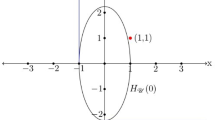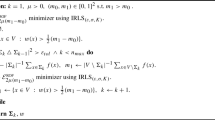Abstract
Analysis of deformable two-dimensional shapes is an important problem, encountered in numerous pattern recognition, computer vision and computer graphics applications. In this paper, we address three major problems in the analysis of non-rigid shapes: similarity, partial similarity, and correspondence. We present an axiomatic construction of similarity criteria for deformation-invariant shape comparison, based on intrinsic geometric properties of the shapes, and show that such criteria are related to the Gromov-Hausdorff distance. Next, we extend the problem of similarity computation to shapes which have similar parts but are dissimilar when considered as a whole, and present a construction of set-valued distances, based on the notion of Pareto optimality. Finally, we show that the correspondence between non-rigid shapes can be obtained as a byproduct of the non-rigid similarity problem. As a numerical framework, we use the generalized multidimensional scaling (GMDS) method, which is the numerical core of the three problems addressed in this paper.
Similar content being viewed by others
References
Bajcsy, R., & Solina, F. (1987) Three dimensional object representation revisited. In Proceedings of ICCV (pp. 231–240).
Belongie, S., Malik, J., & Puzicha, J. (2002). Shape matching and object recognition using shape context. IEEE Transactions on PAMI, 24, 509–522.
Berg, A.C., Berg, T. L., & Malik, J. (2005). Shape matching and object recognition using low distortion correspondences. In Proceedings of CVPR.
Biderman, I. (1985). Human image understanding: recent research and a theory. Computer Graphics, Vision and Image Processing, 32, 29–73.
Binford, T. O. (1987). Visual perception by computer. In Proceedings of IEEE conference on systems and control (pp. 231–240).
Black, M. J., & Anandan, P. (1993). A framework for the robust estimation of optical flow. In Proceedings of ICCV (pp. 231–236).
Borg, I., & Groenen, P. (1997). Modern multidimensional scaling—theory and applications. Berlin: Springer.
Bronstein, A. M., Bronstein, M. M., & Kimmel, R. (2003). Expression-invariant 3D face recognition. In Lecture notes on computer science : Vol. 2688. Proceedings of audio and video-based biometric person authentication (pp. 62–69). Berlin: Springer.
Bronstein, A. M., Bronstein, M. M., & Kimmel, R. (2005a). Three-dimensional face recognition. International Journal of Computer Vision, 64(1), 5–30.
Bronstein, A. M., Bronstein, M. M., & Kimmel, R. (2005b). Expression-invariant face recognition via spherical embedding. In Proceedings of IEEE international conference on image processing (ICIP) (Vol. 3, pp. 756–759).
Bronstein, A. M., Bronstein, M. M., & Kimmel, R. (2005c). On isometric embedding of facial surfaces into \(\mathbb{S}^{3}\) . In Lecture notes on computer science : Vol. 3459. Proceedings of international conference on scale space and PDE methods in computer vision. (pp. 622–631). Berlin: Springer.
Bronstein, A. M., Bronstein, M. M., & Kimmel, R. (2006a). Generalized multidimensional scaling: a framework for isometry-invariant partial surface matching. Proceedings of the National Academy of Sciences, 103(5), 1168–1172.
Bronstein, A. M., Bronstein, M. M., & Kimmel, R. (2006b). Efficient computation of isometry-invariant distances between surfaces, SIAM Journal of Scientific Computing. 28(5), 1812–1836.
Bronstein, A. M., Bronstein, M. M., & Kimmel, R. (2006c). Robust expression-invariant face recognition from partially missing data. In Proceedings of European conference on computer vision (ECCV) (pp. 396–408).
Bronstein, A. M., Bronstein, M. M., & Kimmel, R. (2006d). Face2face: an isometric model for facial animation. In Proceedings of conference on articulated motion and deformable objects (AMDO) (pp. 38–47).
Bronstein, M. M., Bronstein, A. M., Kimmel, R., & Yavneh, I. (2006e). Multigrid multidimensional scaling. Numerical Linear Algebra with Applications (NLAA), 13, 149–171.
Bronstein, A. M., Bronstein, M. M., Bruckstein, A. M., & Kimmel, R. (2006f). Matching two-dimensional articulated shapes using generalized multidimensional scaling. In Proceedings of conference on articulated motion and deformable objects (AMDO) (pp. 48–57).
Bronstein, A. M., Bronstein, M. M., & Kimmel, R. (2007a). Calculus of non-rigid surfaces for geometry and texture manipulation. IEEE Transactions on Visualization and Computer Graphics, 13(5), 902–913.
Bronstein, A. M., Bronstein, M. M., & Kimmel, R. (2007b). Numerical geometry of non-rigid shapes. Berlin: Springer.
Bronstein, A. M., Bronstein, M. M., Devir, Y. S., Kimmel, R., & Weber, O. (2007c). Parallel algorithms for approximation of distance maps on parametric surfaces. (Technical Report CIS-2007-03). Department of Computer Science, Technion, Israel, April 2007. ACM Transactions on Graphics (in press).
Brooks, R. (1981). Symbolic reasoning among 3-D models and 2-D images. Artificial Intelligence, 17, 285–348.
Bruckstein, A. M., Holt, R. J., & Netravali, A. N. (1998). Holographic representations of images. IEEE Transactions on Image Processing, 7(11), 1583–1597.
Burago, D., Burago, Y., & Ivanov, S. (2001). A course in metric geometry. In Graduate studies in mathematics, (Vol. 33). Providence: American Mathematical Society.
Burr, D. (1981). Elastic matching of line drawings. IEEE Transactions on PAMI, 3(6), 708–713.
Charpiat, G., Maurel, P., Pons, J. P., Keriven, R., & Faugeras, O. (2007). Generalized gradients: priors on minimization flows. International Journal of Computer Vision, 73(3), 325–344.
Cheng, S. W., Edelsbrunner, H., Fu, P., & Lam, K. P. (2001). Design and analysis of planar shape deformation. Computational Geometry: Theory and Applications, 19(2–3), 205–218.
Cohen, I., Ayache, N., & Sulger, P. (1992). Tracking points on deformable objects using curvature information. In Proceedings of ECCV (pp. 458–466).
Connell, J. H., & Brady, M. (1987). Generating and generalizing models of visual objects. Artificial Intelligence, 31, 159–183.
de Rooij, S., & Vitanyi, P. (2006). Approximating rate-distortion graphs of individual data: Experiments in lossy compression and denoising. IEEE Transactions on Information Theory (submitted).
Elad, A., & Kimmel, R. (2001). Bending invariant representations for surfaces. In Proceedings of CVPR (pp. 168–174).
Elad, A., & Kimmel, R. (2002). Spherical flattening of the cortex surface. In Lecture notes in computer Science : Vol. 2191. Geometric methods in bio-medical image processing (pp. 77–89). Berlin: Springer.
Eldar, Y., Lindenbaum, M., Porat, M., & Zeevi, Y. Y. (1997). The farthest point strategy for progressive image sampling. IEEE Transactions on Image Processing, 6(9), 1305–1315.
Everson, R. M., & Fieldsend, J. E. (2006). Multi-class ROC analysis from a multi-objective optimization perspective. Pattern Recognition Letters, 27(8), 918–927.
Felzenszwalb, P. F. (2005). Representation and detection of deformable shapes. IEEE Transactions on PAMI, 27(2), 208–220.
Felzenszwalb, P. F., & Huttenlocher, D. P. (2005). Pictorial structures for object recognition. International Journal of Computer Vision, 61(1), 55–79.
Felzenszwalb, P. F., & Schwartz, J. (2007). Hierarchical matching of deformable shapes. In Proceedings of CVPR.
Fischler, M. A., & Elschlager, R. A. (1973). The representation and matching of pictorial structures. IEEE Transactions on Computers, 100(22), 67–92.
Forsyth, D. A., & Ponce, J. (2003). Computer vision: A modern approach. Englewood Cliffs: Prentice Hall.
Gdalyahu, Y., & Weinshall, D. (1999). Flexible syntactic matching of curves and its application to automatic hierarchical classification of silhouettes. IEEE Transactions on PAMI, 21, 1312–1328.
Geiger, D., Liu, T. L., & Kohn, R. (2003). Representation and self-similarity of shapes. IEEE Transactions on PAMI, 25(1), 86–99.
Gelfand, N., Mitra, N. J., Guibas, L., & Pottmann, H. (2005). Robust global registration. In Proceedings of symposium on geometry processing (SGP).
Grenander, U., Chow, Y., & Keenan, D. M. (1991). Hands: A pattern theoretic study of biological shapes. Berlin: Springer.
Gromov, M. (1981). Textes mathématiques: Vol. 1. Structures métriques pour les variétés riemanniennes.
Jacobs, D., & Ling, H. (2005). Deformation invariant image matching. In Proceedings of ICCV.
Hampel, F. R., Ronchetti, E. M., Rousseeuw, P. J., & Stahel, W. A. (1986). Robust statistics: The approach based on influence functions. New York
Hel-Or, Y., & Werman, M. (1994). Constraint-fusion for interpretation of articulated objects. In Proceedings of CVPR (pp. 39–45).
Hildreth, E. (1983). The measurement of visual motion. Cambridge: MIT Press.
Hoffman, D., & Richards, W. (1984). Visual cognition. In Parts of recognition. Cambridge: MIT Press.
Huber, P. J. (2004). Robust statistics. New York: Wiley.
Jacobs, D., Weinshall, D., & Gdalyahu, Y. (2000). Class representation and image retrieval with non-metric distances. IEEE Transactions on PAMI, 22, 583–600.
Jain, A., Zhong, Y., & Lakshmanan, S. (1996). Object matching using deformable templates. IEEE Transactions on PAMI, 3(18), 267–278.
Kass, M., Witkin, A., & Terzopoulos, D. (1988). Snakes: active contour models. International Journal of Computer Vision, 1(4), 321–331.
Kimmel, R., & Sethian, J. A. (1998). Computing geodesic on manifolds. In Proceedings of US National Academy of Science (Vol. 95, pp. 8431–8435).
Klir, G. J., & Yuan, B. (1994). Fuzzy sets and fuzzy logic: theory and applications. Englewood Cliffs: Prentice Hall.
Koenderink, J. J., & van Doorn, A. J. (1981). The shape of smooth objects and the way contours end. Perception, 11, 129–137.
Kupeev, K., & Wolfson, H. (1994). On shape similarity. In Proceedings of international conference on pattern recognition (pp. 227–237).
Lades, M., Vorbruggen, J. C., Buhmann, J., Lange, J., von der Malsburg, C., Wurtz, R. P., & Konen, W. (1993). Distortion invariant object recognition in the dynamic link architecture. IEEE Transactions on Computers, 42(3), 300–311.
Latecki, L. J., & Lakamper, R. (2000). Shape similarity measure based on correspondence of visual parts. IEEE Transactions on PAMI, 22(10), 1185–1190.
Latecki, L. J., Lakamper, R., & Wolter, D. (2005). Optimal partial shape similarity. Image and Vision Computing, 23, 227–236.
Ling, H., & Jacobs, D. (2005). Using the inner-distance for classification of articulated shapes. In: Proceedings of CVPR.
Mémoli, F., & Sapiro, G. (2005). A theoretical and computational framework for isometry invariant recognition of point cloud data. Foundations of Computational Mathematics, 5(3), 313–347.
Michor, P. W., & Mumford, D. (2003). Riemannian geometries on spaces of plane curves. Arxiv preprint math.DG/0312384.
Mio, W., Srivastava, A., & Joshi, S. (2007). On shape of plane elastic curves. International Journal of Computer Vision, 73(3), 307–324.
Mumford, D. (1991). Mathematical theories of shape: do they model perception? In Proceedings of SPIE (pp. 2–10).
Pareto, V. (1906). Manuale di economia politica.
Pentland, A. (1987). Recognition by parts. In Proceedings of ICCV (pp. 612–620).
Platel, B., Balmachnova, E., Florack, L. M. J., Kanters, F. M. W., & ter Haar Romeny, B. M. (2005). Using top-points as interest points for image matchng. In Lecture notes in computer science (Vol. 3753, p. 211).
Geiger, D., Basri, R., Costa, L., & Jacobs, D. (1998). Determining the similarity of deformable shapes. Vision Research, 38, 2365–2385.
Rivlin, E., Dickenson, S., & Rosenfeld, A. (1992). Recognition by functional parts. In Proceedings of CVPR (pp. 267–275).
Salukwadze, M. E. (1979). Vector-valued optimization problems in control theory. Orlando: Academic Press.
Sethian, J. A. (1996). A review of the theory, algorithms, and applications of level set method for propagating surfaces. Acta numerica 309–395.
Siddiqi, K., & Kimia, B. (1996). A shock grammar for recognition. In Proceedings of CVPR (pp. 507–513).
Spira, A., & Kimmel, R. (2004). An efficient solution to the eikonal equation on parametric manifolds (Vol. 6, pp. 315–327).
Stark, L., & Bowyer, K. (1991). Achieving generalized object recognition through reasoning about association of function to structure. IEEE Transactions on PAMI, 10(13), 992–1006.
Tappert, C. (1982). Cursive script recognition by elastic matching. IBM Journal of Research and Development, 26(6), 765–771.
Ullman, S. (1989). Aligning pictorial descriptions: an approach to object recognition. Cognition, 3(32), 193–254.
Walter, J., & Ritter, H. (2002). On interactive visualization of high-dimensional data using the hyperbolic plane. In Proceedings of ACM SIGKDD int. conference on knowledge discovery and data mining (pp. 123–131).
Yezzi, A., & Mennucci, A. (2004). Metrics in the space of curves. Arxiv preprint math.DG/0412454.
Yuille, A., Cohen, D., & Hallinan, P. (1989). Feature extraction from faces using deformable templates. In Proceedings of CVPR (pp. 104–109).
Zadeh, L. A. (1965). Fuzzy sets. Information and Control, 8, 338–353.
Zadeh, L. A. (1978). Fuzzy sets as a basis for a theory of possibility. Fuzzy Sets and Systems, 1(1), 3–28.
Zhang, J., Collins, R., & Liu, Y. (2004). Representation and matching of articulated shapes. In Proceedings of CVPR (Vol. 2, pp. 342–349).
Zimmermann, H. J. (2001). Fuzzy set theory and its applications. Dordrecht: Kluwer Academic.
Author information
Authors and Affiliations
Corresponding author
Rights and permissions
About this article
Cite this article
Bronstein, A.M., Bronstein, M.M., Bruckstein, A.M. et al. Analysis of Two-Dimensional Non-Rigid Shapes. Int J Comput Vis 78, 67–88 (2008). https://doi.org/10.1007/s11263-007-0078-4
Received:
Accepted:
Published:
Issue Date:
DOI: https://doi.org/10.1007/s11263-007-0078-4




